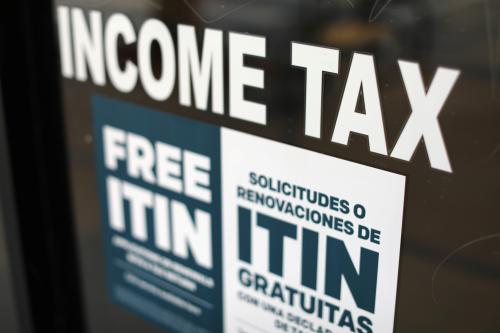The budget proposal Rep. Paul Ryan released yesterday is, essentially, an effort to have low- and middle-class households bear the entire burden of closing the fiscal gap and to have them bear the costs of financing an additional tax cut for high income households
Yesterday, the Tax Policy Center (disclaimer: which I co-direct) analyzed the revenue policies as proposed by Rep. Ryan. We simulated the effects of repealing the AMT and reducing ordinary income tax rates to 10 and 25 percent. These proposals would cost about $3.2 trillion over ten years, on top of the $0.3 trillion lost from repealing taxes enacted to pay for Affordable Care Act, the $1.1 trillion lost from his desired reduction in the corporate tax rate, and the $5.4 trillion lost from first extending the Bush-Obama tax cuts (which he also supports). By 2022, the tax policies he has specified would lower federal revenues to just 15.8 percent of GDP. Talk about digging yourself a hole.
Rep. Ryan claims he can fill this hole by eliminating tax breaks, which he correctly identifies as “spending through the tax code.” At first glance, this sounds like a step in the right direction: broaden the base and lower rates. Yet, like many recent proposals, the devil is in the details. Rep. Ryan never specifies which specific tax expenditures he would cut.
At a time when our country faces a daunting fiscal challenge, Ryan asks nothing of the wealthiest Americans. His budget proposal would simultaneously cut tax rates for the rich and corporations while slashing programs for the poor and elderly: he would shift many federal low-income assistance programs to state governments and would transform Medicare into a premium support system that will shift health care costs to seniors if health care inflation cannot be controlled.
Although I agree that spending cuts are necessary to meet our fiscal challenges, so too are additional revenues, for many reasons. They are the only way to get shared sacrifice from the wealthiest Americans. They could reduce the draconian spending cuts that Ryan proposes. Until he specifies which popular tax breaks he would eliminate, the Republican’s budget is clearly a win for the rich and a loss for everyone else.
Lastly, it is worth highlighting that Rep. Ryan is gaming the system in creating budget estimates. Ryan’s budget proposal is too vague to be scored, so he simply told the Congressional Budget Office (CBO) to determine the effect of his budget proposal assuming the proposal achieves its stated goals for spending and revenues. This is not the same as the usual approach—which involves asking CBO to determine whether the proposal actually achieves its stated goals. Instead, Ryan dictates the assumptions he wants and walks away with a seemingly favorable CBO report. This is smoke and mirrors. Ryan may not be the only politician to use the system this way, but that doesn’t make his actions any more forthright or reveal anything informative about this plan.






Commentary
A Review of Paul Ryan’s Budget Proposal
March 21, 2012